
Category Archive: PHLF News
-
Committee Selects 2021 Landmarks Scholarship Winners

One of the 2021 Landmarks Scholarship recipients focused his application essay on the National Negro Opera House located in Homewood, which was last year listed as one of the 11 Most Endangered Historic Places by the National Trust for Historic Preservation.
Our Landmarks Scholarship, now in its twenty-third year, connects college-bound high school students who live in Allegheny County, have a 3.25-grade point average or above, are involved in their community, and care deeply about the Pittsburgh region with the resources to support their continuing education. The Scholarship Committee recently announced this year’s award recipients with the goal of helping as many young people as possible. “Just as we did last year, we really tried to be a ray of light and hope in a high-school students’ challenging experience during 2020 and 2021,” said David Brashear, Committee chair and founder of our Scholarship program.
Our Scholarship Committee is pleased to announce the following winners:
2021 Scholarship Recipients
(Each scholarship has a maximum value of $6,000 and is payable over a four-year period to the recipient’s college/university student account. The scholarship is for book and tuition expenses.)
- Sage Arnold (Pittsburgh Allderdice /University of Rochester)
- Drew Young (Oakland Catholic/South Carolina Agricultural and Technical State University)
- Eric Gary (Kiski School/Allegheny College)
2021 Honorable Mention Recipients
(This is a one-time payment of $250 to the recipient’s college/university student account.)
- Ilham Ariouat (Bethel Park High School/Chatham University)
- Natalie Beinlich (Elizabeth Forward High School/Washington and Lee University)
- Ryan Boyle (McKeesport Area Senior High School/University of Florida)
- Sylvia Donahue (West Allegheny High School/Penn State University)
- Elijah Duckworth (North Allegheny Senior High School/Undecided)
- Gil Isaac Gabriel (City Charter High School/ West Chester University of Pennsylvania)
- Graham Herzig (Avonworth High School/Penn State University)
- Yunshu Li (North Allegheny Senior High School/Carnegie Mellon University)
- Gwendolyn Nace (Quaker Valley High School/Pratt Institute)
- Benjamin Stalder (Aquinas Academy/University of Richmond)
Congratulations to all!
As part of the process, applicants were asked to write an essay about a place in Allegheny County that is important to them. “The students’ insights into the landmark places of Allegheny County are incredibly moving; they demonstrate that even during difficult times, connections to our community landmarks are what anchor and sustain us,” said co-director of education Sarah Greenwald.
Excerpts from some of the essays include the following insights:
- Frick Park: “Although my time in Frick Park is most often spent by myself, I never feel alone knowing the beautiful natural history of the woods. […] The centuries of history embedded in the soil of Frick Park teach lessons about the importance of maintaining balance in tumultuous times.”
- August Wilson African American Cultural Center: “The building is a pure work of art. It was purposefully constructed on a corner in downtown Pittsburgh. The exterior of the building was inspired by ships that transported Swahili culture from West Africa. Additionally, the exterior material is composed of metal, stone, and glass which provides an illusion of movement and freedom. […] I identify with its position on the corner in the middle of downtown because it signifies a crossroad––which I feel as a senior in high school, about to transition to a college freshman.”
- National Negro Opera House: “Through all the years of wear and tear it is still standing. I believe in my heart that a miracle is going to take place and the historically important building will receive the needed funding and can be saved for all to see.”
“As one recipient so eloquently wrote: ‘I love helping kids. I know when we start them young, we can plant a seed and watch them grow.’ Our Scholarship Program does just that by supporting these young leaders and being an organization that gives them a way to always re-connect with and value their hometown,” said Louise Sturgess, education advisor. “We are grateful to the Brashear Family, to committee members, and to other donors who so generously support our annual Scholarship Program.”
-
Joint Jewish Education Program Explores Landmark Buildings
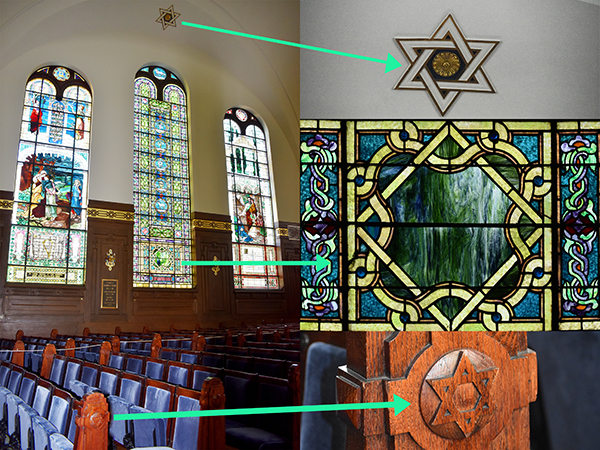
JJEP’s Landmark Art: Inspiration from Our Buildings course explored the oft-hidden details in our landmark buildings that reflect our values––beauty, spirituality, teamwork, social responsibility, and more.
Pittsburgh’s Joint Jewish Education Program (JJEP), which included an elective class titled Landmark Art: Inspiration from Our Buildings, concluded in April. The class, an exploration of landmark buildings was taught by Sarah Greenwald, our organization’s co-director of education. The students in the program came from Congregations Beth Shalom and Rodef Shalom in Pittsburgh’s Squirrel Hill and Oakland neighborhoods, respectively.
Sarah guided students as they studied the foundations of architecture, learned to “read” values reflected in artistic symbols found on and in our historic buildings, created art inspired by these buildings, and discussed the importance of historic preservation. As one student so eloquently stated: “If it is made with care, and has its own unique features, it [a building] can be art.”
“Seeing these students grow to appreciate the landmark buildings of Pittsburgh’s Jewish community was a highlight of this course,” Sarah said. “I was impressed with how deeply students used this elective to think about the historic buildings around them and understand how our buildings are works of art and how they reflect our values and carry them into the future.”
As part of this course, students were asked to share their thoughts on historic preservation: Is it important? Why or why not? Some of their insights include:
“Historic preservation is important. It [The historic structure] could educate people, house people, serve as a memorial. Like Pittsburgh’s bridges, we have a lot of bridges [and] we are known for our bridges, so we should save them. They are a part of who we are.”
“They [our buildings] are a part of history. It is important to save them. For example, if a movie theater survived a nuclear war, it would tell people who survived about the past.”
Students worked diligently from home during this virtual course, completing several art-based activities, and taking virtual explorations to jumpstart their learning. “I look forward to exploring the artistry of Pittsburgh’s landmark buildings in person, next time, with these students and others,” said Sarah.
-
“Building Pride, Building Character” Program Nurtures Citizenship Skills
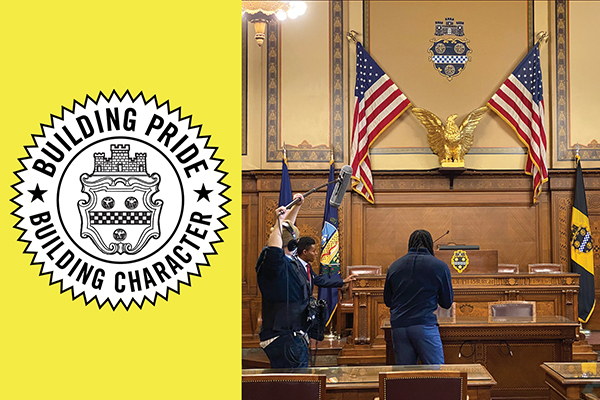
This year, the “Building Pride, Building Character” program is being offered in a virtual format, teaching Pittsburgh Public School students about Pittsburgh’s history and architecture, and the people who work to improve our communities. Pictured here are videographer Randall Coleman of Reddvision and sound technician Tyler Vietmeier filming James Hill (Special Assistant to Mayor Bill Peduto) sharing the historic beauty and function of Pittsburgh’s City Council Chambers with students.
As part of our Building Pride, Building Character EITC program, Pittsburgh Public School students from Dilworth met virtually on March 12, with City Councilwoman Deborah Gross to learn more about city government and to discuss the strengths and weaknesses of their neighborhood.
After a 30-minute conversation, Dilworth teachers Stephanie Hornick, Cory Herschk, and Lauren Freeman, sent thank you notes created by the students to Councilwoman Gross and noted that “you gave us lots of great things to talk about during Social Studies class.”
“It was inspiring to hear third-grade students sharing their concerns about vacant buildings, roads, and green spaces in their neighborhoods,” said Co-director of Education Sarah Greenwald. “They clearly know and value their community and want to take care of it––and that is a primary goal of our EITC program.” This was the second virtual meeting between third-grade students and City Council representatives: students from Pittsburgh Roosevelt met with Blake Plavchak, Councilman Coghill’s Chief of Staff, on February 23.
We also recently released another educational video for use in third- and fourth-grade classrooms. The “Dollar Bank Heritage Center” video is the first stop on our virtual Pittsburgh People & Places field trip. “Through exhibits and artifacts housed in the remarkable Dollar Bank Heritage Center, we introduce the art of writing biographies to fourth-grade students,” said Education Advisor Louise Sturgess. “We especially thank Dorothy Spangler of Dollar Bank for providing historical images and information for our use.”
Videographer Randall Coleman and Tyler Vietmeier, a sound technician, are in the process of editing six more videos; three more architectural landmarks will be filmed in April, with editing to follow.
We thank S&T Bank for recently contributing to PHLF’s “Building Pride, Building Character” educational program, made possible through the Pennsylvania Department of Community and Economic Development’s Educational Improvement Tax Credit program. Click here for a complete list of donors who are underwriting our virtual programming with the Pittsburgh Public Schools through mid-June.
-
Newcomers Explore Historic Neighborhoods
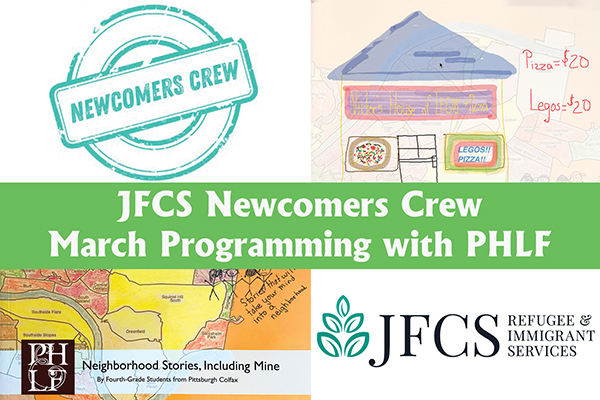
PHLF’s March programming with the Jewish Family & Community Services’ Newcomers Crew included using PHLF’s exploratory book, “Neighborhood Stories, Including Mine,” and virtual exploration of Pittsburgh’s Strip District, with students adding their own store to the National Register Historic District. “Victor’s House of Pizza and Lego’s” is pictured here.
The Jewish Family & Community Services’ Newcomers Crew is a virtual after-school mentoring program for recently resettled refugee youth in Pittsburgh. JFCS staff, mentors, and participants share information about their respective cultures, learn about America, Pittsburgh, and their countries of origin.
Sarah Greenwald, PHLF co-director of education, introduced participants to their new hometown through several activities. Club members and their mentors used Neighborhood Stories, Including Mine, recently published by PHLF, to learn more about their family, neighborhood, and community. Then, they explored the Strip District with Sarah, who shared information about its historic landmarks, family-owned businesses, and cultural diversity. Club members then worked with their mentors to add a business to the Strip based on their culture. They envisioned Pizza, Legosã, specialty bakeries, clothes, and grocery stores, among other ideas.
With PHLF, JFCS Newcomers Crew members also explored Pittsburgh’s Market Square, Forbes Avenue and Wood Street area, hearing from the local and woman-owned business Boutique La Passerelle, thanks to owner Adele Morelli. Additionally, club members learned more about the rich history of “Mystery Manor,” the National Negro Opera House in Homewood. Music and poetry came alive for participants in new ways through this particular historic structure and the rich legacy of Mary Cardwell Dawson. Inspired by Mary Cardwell Dawson’s story, some members created short poems in their native language, while others composed original music lyrics.
Each of these activities gave club members a sense of belonging in Pittsburgh. “I am always inspired by these club members,” said Sarah. “We learn from them as much as they learn from us. In the process, we all foster the sense that saving and sharing the historic fabric of our communities is important for our future.”
PHLF thanks the McSwigan Family Foundation Fund of The Pittsburgh Foundation for supporting its place-based education programs.
-
15 Years of Our “Building Pride, Building Character” EITC Program
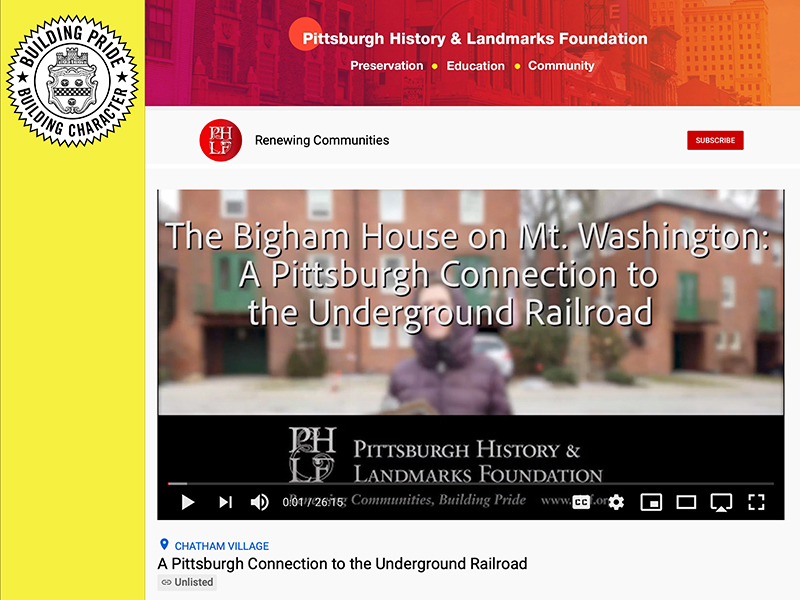
This year, our “Building Pride, Building Character” program is being offered in remote and virtual formats. This program teaches Pittsburgh Public School students about Pittsburgh’s history and architecture, and the people who work to improve our communities.
This spring, our fifteenth year of place-based education programs with Pittsburgh Public School students continues, with the creation of videos so this popular program can be experienced virtually. “We are also arranging virtual discussions with City Council representatives, working with SLB Radio Productions to record neighborhood stories written by students, and providing a series of PDFs based on our Career Awareness posters, and working with SLB Radio Productions to record stories written by students,” said Education Advisor Louise Sturgess.
PHLF released its first educational video on February 15 to a group of fifth-grade teachers in the Pittsburgh Public Schools. The 26-minute video, “The Bigham House on Mt. Washington: A Pittsburgh Connection to the Underground Railroad,” includes a walk through the woods and a tour of the mansion built in 1849 by abolitionist Thomas Bigham. Architect David Vater, a resident of Chatham Village, joined Louise Sturgess in narrating the video, and Chatham Village’s Board of Directors gave special permission so filming could take place inside the Bigham House. After watching the video, students from Pittsburgh Whittier completed writing prompts describing times in their lives when they felt free, and students from Pittsburgh Minadeo discussed how the video reinforced some of the experiences they had read about in the book, “The Road to Freedom.”
On February 23, PHLF facilitated a virtual conversation between Ms. Dulak’s third-grade students from Pittsburgh Roosevelt and Blake Plavchak, Chief of Staff for Councilman Anthony Coghill. Mr. Plavchak listened attentively to the students as they shared their ideas about what needs to be improved in Carrick and what is wonderful about their neighborhood. He told the students they were “completely accurate” in the concerns and attributes they noted, and encouraged them to keep talking with their elected officials. He appreciated how much they cared about their neighborhood and encouraged them to stay involved.
This program is made possible through the Pennsylvania Department of Community and Economic Development’s Educational Improvement Tax Credit (EITC) program. We are grateful to Dollar Bank for contributing recently and to seven corporate donors who contributed between November and December 2020. Donations from the following are underwriting our “Building Pride, Building Character” virtual programming with the Pittsburgh Public Schools through mid-June:
Lead
- First National Bank of Pennsylvania
Major
- The Buncher Company
- Dollar Bank
- PNC Bank
Patron
- Frank B. Fuhrer Wholesale Company
- Hefren-Tillotson, Inc.
- MaherDuessel, CPA
- Pickands Mather & Company
This program also receives foundation support from the:
- McSwigan Family Foundation Fund of The Pittsburgh Foundation.
-
Society of Architectural Historians Grant to Support Education Programs
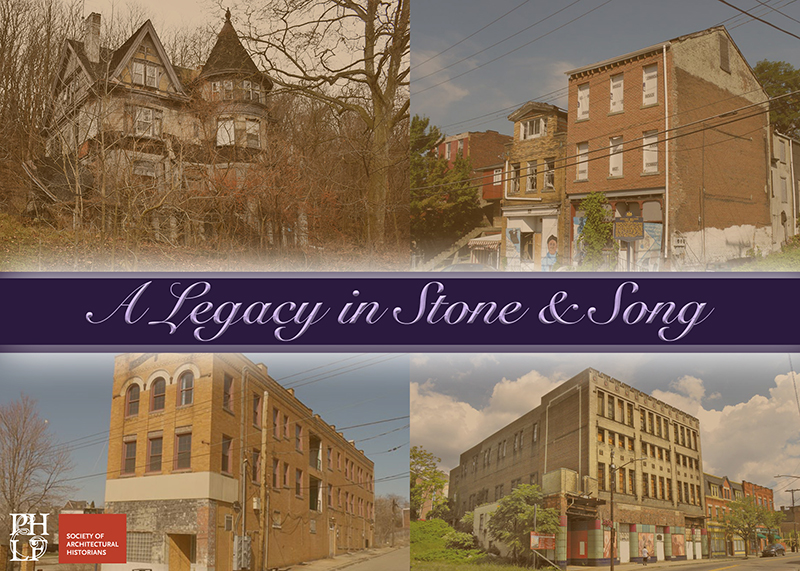
A Legacy in Stone & Song brings to life the architecture and history of the National Negro Opera House and other significant African-American landmarks in Pittsburgh. After touring these places virtually, students will complete creative projects inspired by these landmarks.
The Society of Architectural Historians has awarded the Pittsburgh History & Landmarks Foundation a $5,000 grant to fund programs for students from two Pittsburgh public schools to explore the architecture and history of the National Negro Opera House in Pittsburgh’s Homewood neighborhood.
The grant, made possible by the Society’s American Architecture and Landscape Field Trip program, together with funding from the McSwigan Family Foundation Fund of The Pittsburgh Foundation, and PHLF, will fund this educational program and other significant African-American sites in Pittsburgh including the New Granada Theater, Crawford Grill, August Wilson House, and August Wilson African American Cultural Center.
The story of each of these places is important in the history of our region and our nation and will be shared by the people who know them best. After a virtual tour, Pittsburgh Public School students will develop inspiring creative projects based on these significant African-American landmarks.
The SAH American Architecture and Landscape Field Trip grant recognizes the value of our Legacy in Stone and Song field trip program. Every place has a story, and the National Negro Opera House (NNOH) is especially noteworthy. This Queen Anne style house was included on the list of America’s 11 Most Endangered Historic Places by the National Trust for Historic Preservation in 2020.
Owned by William “Woogie” Harris, the house served as a home for the National Negro Opera Company, the nation’s first permanent all-Black opera company, led by the indomitable Madame Mary Cardwell Dawson. It also served as a temporary haven for national luminaries in entertainment and sports, many of whom were barred from white accommodations when traveling in Pittsburgh. Today, the National Opera House survives as the physical embodiment of Pittsburgh’s vibrant African American heritage.
Our organization’s education programs are always in need of your help! To support this program, please click HERE, and direct your contribution to “Education Programs.”
-
NEW! Virtual K-12 Walking Tours Now Available

PHLF Education is offering two NEW virtual student walking tours, in addition to virtual tours of its many in-person tours. Pittsburgh’s Hill District explores the legacy of August Wilson through Pittsburgh’s Hill District, and Pittsburgh’s Innovators looks at the inspiring people whose places in our city are named for them.
PHLF Education is excited to announce that we are now offering two new virtual tours in addition to virtual tours of our popular in-person student tours. Thanks to open-source mapping technology (Google Maps), PHLF staff and docents can lead participants along a tour route in real-time, as if walking on the street, but within the space of a computer screen. The laminated historical images that enrich our in-person tours continue to provide context and evidence of change over time to the tour, and our conversations with learners will remain as engaging as ever. PHLF is grateful to the McSwigan Family Foundation Fund of The Pittsburgh Foundation whose support of its educational programs this year is helping underwrite the development of these new initiatives. Keep reading to learn more about our new and existing offerings, and how to schedule yours today!
Pittsburgh’s Hill District
Inspired by August Wilson’s work, and using PHLF’s guidebook August Wilson: Pittsburgh Places in His Life and Plays, students explore landmarks of Pittsburgh’s Hill District, learning about the neighborhood’s history and the influence Pittsburgh had on the playwright’s work. This tour also comes with a complimentary copy of the guidebook for your classroom library, along with a digital copy of PHLF’s African American Legacy in Allegheny County: A Timeline of Key Events.
Pittsburgh’s Innovators
Pittsburgh’s history is intertwined with the history of many of our nation’s innovators in science, the arts, sports, philanthropy, and more. Their legacy lives on in the historic places around us––the many bridges, buildings, parks, and other structures bearing their names. This tour explores the determination and hard work of several of these pioneers through the places named for them––people like Andy Warhol, Rachel Carson, Roberto Clemente, HJ Heinz, and others. Along the way, students will “travel” across several historic bridges and explore Pittsburgh’s downtown and North Shore neighborhoods.
In addition to these tours, educators can also schedule a virtual tour of any of our traditional in-person tours. Search for Downtown Dragons and Other Creatures Carved in Stone; or travel the world in just a few blocks on our Strip District Stroll; match colorful architectural details to correct buildings and learn about the history of the North Side on our North Side’s Historic Neighborhoods tour––whatever your classroom needs, we have the tour to match!
Let us plan your field trip for any number of students (grades 2 and above) who want to explore the architecture and history of downtown Pittsburgh or of a local neighborhood. We have over 40 years of experience in planning school field trip tours—and many creative ideas. Click here to schedule a tour. Don’t see a tour that fits your classroom needs? Email co-director of education Sarah Greenwald sarahg@phlf.org to tailor a tour.
-
Now Offering Virtual Architectural Tours
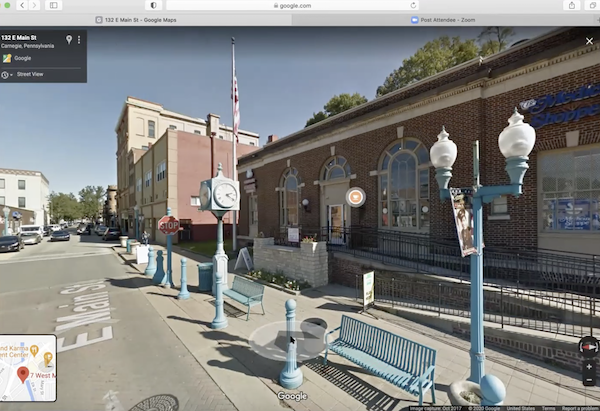
A combination of navigating streets on Google Maps, live narration by docents, and a slide presentation of supplemental material creates virtual versions of our beloved architecture tours. Shown here: a screen shot of a virtual tour of Carnegie, Pennsylvania, in November 2020.
We are delighted to announce that we will resume offering tours of Pittsburgh’s extraordinary architecture, which have been a mainstay of our education program for decades, this month. Our staff and dedicated docents would love to be outdoors with you— even in the cold weather —after so many months of confinement. However, in respect of Allegheny County’s public health guidelines for tackling the Covid-19 pandemic, we will instead offer live virtual tours.
Our virtual tours will be offered via Zoom Conference. Thanks to open-source mapping technology (Google Maps), docents can lead participants along a tour route in real time, as if walking on the street, but within the space of your computer screen. The laminated historical images that bring texture to our in-person tours also are shown in our virtual tours, as interjections of PowerPoint slides in the docents’ live narrative. Through the chat function in Zoom Conference, participants can engage with the docents and each other, much as they would on the street.
The result is a true multimedia presentation that allows participants to enjoy architecture tours from the comfort of their own homes. In fact, comfort is the operative term. As docent and former PHLF staff member has Karen Cahall pointed out, “on virtual tours, we can avoid things like bad weather, uneven or narrow sidewalks, and noise from traffic that sometimes challenge us on in-person tours.”
Google Maps also provides views that can’t be seen on in-person tours, by allowing us to scroll up a building to see details, zoom out for an aerial view, and travel farther than our feet could normally carry us in a single hour.
“We are truly excited to be able to offer tours again,” said Tracy Myers, co-director of education at PHLF. “I don’t believe any of our counterparts are doing tours in this way, and we’re eager to see how participants react to them. We’ve had to re-think each tour a little bit to accommodate the format, and as in every tech-enabled activity, there are occasional glitches. Our docents are working hard, though, to create authentic experiences, to remind us all why we love Pittsburgh’s architecture and history.”
Registration for tours will open on Saturday, December 5, and must be completed online. The fee is $7.50. For additional information, and to register, go to www.phlf.org/events.
